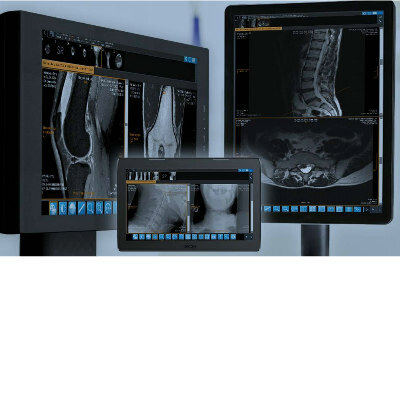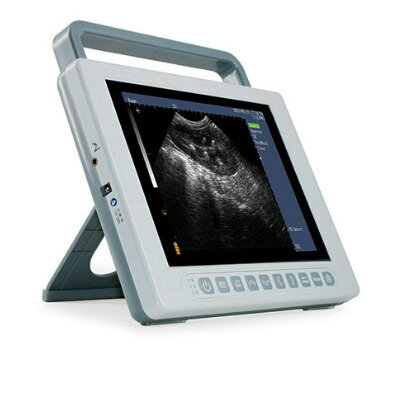MRI Identifies Early Breast Cancer in At-Risk Survivors of Childhood Hodgkin Lymphoma
|
By MedImaging International staff writers Posted on 04 Jun 2014 |
Magnetic-resonance imaging (MRI) has been shown to identify invasive breast tumors at very early stages, when cure rates are expected to be excellent, according to recent findings of the largest clinical study ever done to evaluate breast cancer screening of female survivors of childhood Hodgkin lymphoma (HL). These patients are at increased risk because they received chest radiation.
The findings, published online May 28, 2014, in the American Cancer Society’s journal Cancer, emphasizes the need for at-risk childhood HL survivors and primary care physicians to be cognizant of established guidelines that advocate breast MRI screening from the age of 25 years or eight years after chest radiation (whichever is later), according to lead investigator Dr. David Hodgson, a radiation oncologist at Princess Margaret Cancer Center, University Health Network (UHN; Toronto, ON, Canada).
“Female survivors of childhood HL who had chest radiation should speak with their family doctor about after-care assessment and breast cancer screening,” remarked Dr. Hodgson. “We estimate that 75% of women who are at high risk because of prior radiotherapy to the chest are not being screened. So my hope is that this new evidence will encourage these survivors to discuss early screening with their physicians. There is a provincial pediatric oncology aftercare system already in place to help them, organized by the Pediatric Oncology Group of Ontario [POGO].”
Dr. Hodgson’s study colleagues, in collaboration with colleagues at the Dana Farber Cancer Institute (Boston, MA, USA), performed 274 breast MRI scans on 96 women from 2005 to 2012. Ten breast tumors—50% of them invasive cancers—were diagnosed in nine women during 363 person-years follow up. The median age of breast cancer diagnosis was 39 years (range 24 to 43 years), and the median latency time period between HL diagnosis and age at breast cancer diagnoses was 21 years (range 12 to 27 years). “This illustrates the young age at which these cancers can occur. For some of these women, if they had been screened starting at age 40 or 50 like average risk women, it would have been too late,” commented Dr. Hodgson.
Of the 10 identified breast tumors, five were seen on both MRI and mammogram; three were visible only on MRI; and two were detected on mammogram by itself (but were noninvasive). The median size of invasive tumors size was 8 mm (range 3–15 mm) and none had metastasized to the lymph nodes. These findings are considerably better than earlier studies using only mammographic screening in these young patients, in which almost half of the cancers identified had cancer spread to the lymph nodes.
Dr. Hodgson noted that because MRI screening is so much more sensitive to small alterations in the appearance of the breast tissue than mammography, up to one-third of patients may be called back for further testing of suspicious findings, many of which are benign or not clinically significant and therefore require no treatment. “It’s important to forewarn at-risk HL survivors because call backs definitely heighten anxiety.”
Related Links:
Princess Margaret Cancer Center
Dana Farber Cancer Institute
The findings, published online May 28, 2014, in the American Cancer Society’s journal Cancer, emphasizes the need for at-risk childhood HL survivors and primary care physicians to be cognizant of established guidelines that advocate breast MRI screening from the age of 25 years or eight years after chest radiation (whichever is later), according to lead investigator Dr. David Hodgson, a radiation oncologist at Princess Margaret Cancer Center, University Health Network (UHN; Toronto, ON, Canada).
“Female survivors of childhood HL who had chest radiation should speak with their family doctor about after-care assessment and breast cancer screening,” remarked Dr. Hodgson. “We estimate that 75% of women who are at high risk because of prior radiotherapy to the chest are not being screened. So my hope is that this new evidence will encourage these survivors to discuss early screening with their physicians. There is a provincial pediatric oncology aftercare system already in place to help them, organized by the Pediatric Oncology Group of Ontario [POGO].”
Dr. Hodgson’s study colleagues, in collaboration with colleagues at the Dana Farber Cancer Institute (Boston, MA, USA), performed 274 breast MRI scans on 96 women from 2005 to 2012. Ten breast tumors—50% of them invasive cancers—were diagnosed in nine women during 363 person-years follow up. The median age of breast cancer diagnosis was 39 years (range 24 to 43 years), and the median latency time period between HL diagnosis and age at breast cancer diagnoses was 21 years (range 12 to 27 years). “This illustrates the young age at which these cancers can occur. For some of these women, if they had been screened starting at age 40 or 50 like average risk women, it would have been too late,” commented Dr. Hodgson.
Of the 10 identified breast tumors, five were seen on both MRI and mammogram; three were visible only on MRI; and two were detected on mammogram by itself (but were noninvasive). The median size of invasive tumors size was 8 mm (range 3–15 mm) and none had metastasized to the lymph nodes. These findings are considerably better than earlier studies using only mammographic screening in these young patients, in which almost half of the cancers identified had cancer spread to the lymph nodes.
Dr. Hodgson noted that because MRI screening is so much more sensitive to small alterations in the appearance of the breast tissue than mammography, up to one-third of patients may be called back for further testing of suspicious findings, many of which are benign or not clinically significant and therefore require no treatment. “It’s important to forewarn at-risk HL survivors because call backs definitely heighten anxiety.”
Related Links:
Princess Margaret Cancer Center
Dana Farber Cancer Institute
Latest MRI News
- PET/MRI Improves Diagnostic Accuracy for Prostate Cancer Patients
- Next Generation MR-Guided Focused Ultrasound Ushers In Future of Incisionless Neurosurgery
- Two-Part MRI Scan Detects Prostate Cancer More Quickly without Compromising Diagnostic Quality
- World’s Most Powerful MRI Machine Images Living Brain with Unrivaled Clarity
- New Whole-Body Imaging Technology Makes It Possible to View Inflammation on MRI Scan
- Combining Prostate MRI with Blood Test Can Avoid Unnecessary Prostate Biopsies
- New Treatment Combines MRI and Ultrasound to Control Prostate Cancer without Serious Side Effects
- MRI Improves Diagnosis and Treatment of Prostate Cancer
- Combined PET-MRI Scan Improves Treatment for Early Breast Cancer Patients
- 4D MRI Could Improve Clinical Assessment of Heart Blood Flow Abnormalities
- MRI-Guided Focused Ultrasound Therapy Shows Promise in Treating Prostate Cancer
- AI-Based MRI Tool Outperforms Current Brain Tumor Diagnosis Methods
- DW-MRI Lights up Small Ovarian Lesions like Light Bulbs
- Abbreviated Breast MRI Effective for High-Risk Screening without Compromising Diagnostic Accuracy
- New MRI Method Detects Alzheimer’s Earlier in People without Clinical Signs
- MRI Monitoring Reduces Mortality in Women at High Risk of BRCA1 Breast Cancer
Channels
Radiography
view channel
Novel Breast Imaging System Proves As Effective As Mammography
Breast cancer remains the most frequently diagnosed cancer among women. It is projected that one in eight women will be diagnosed with breast cancer during her lifetime, and one in 42 women who turn 50... Read more
AI Assistance Improves Breast-Cancer Screening by Reducing False Positives
Radiologists typically detect one case of cancer for every 200 mammograms reviewed. However, these evaluations often result in false positives, leading to unnecessary patient recalls for additional testing,... Read moreUltrasound
view channel
Deep Learning Advances Super-Resolution Ultrasound Imaging
Ultrasound localization microscopy (ULM) is an advanced imaging technique that offers high-resolution visualization of microvascular structures. It employs microbubbles, FDA-approved contrast agents, injected... Read more
Novel Ultrasound-Launched Targeted Nanoparticle Eliminates Biofilm and Bacterial Infection
Biofilms, formed by bacteria aggregating into dense communities for protection against harsh environmental conditions, are a significant contributor to various infectious diseases. Biofilms frequently... Read moreNuclear Medicine
view channel
New SPECT/CT Technique Could Change Imaging Practices and Increase Patient Access
The development of lead-212 (212Pb)-PSMA–based targeted alpha therapy (TAT) is garnering significant interest in treating patients with metastatic castration-resistant prostate cancer. The imaging of 212Pb,... Read moreNew Radiotheranostic System Detects and Treats Ovarian Cancer Noninvasively
Ovarian cancer is the most lethal gynecological cancer, with less than a 30% five-year survival rate for those diagnosed in late stages. Despite surgery and platinum-based chemotherapy being the standard... Read more
AI System Automatically and Reliably Detects Cardiac Amyloidosis Using Scintigraphy Imaging
Cardiac amyloidosis, a condition characterized by the buildup of abnormal protein deposits (amyloids) in the heart muscle, severely affects heart function and can lead to heart failure or death without... Read moreGeneral/Advanced Imaging
view channel
New AI Method Captures Uncertainty in Medical Images
In the field of biomedicine, segmentation is the process of annotating pixels from an important structure in medical images, such as organs or cells. Artificial Intelligence (AI) models are utilized to... Read more.jpg)
CT Coronary Angiography Reduces Need for Invasive Tests to Diagnose Coronary Artery Disease
Coronary artery disease (CAD), one of the leading causes of death worldwide, involves the narrowing of coronary arteries due to atherosclerosis, resulting in insufficient blood flow to the heart muscle.... Read more
Novel Blood Test Could Reduce Need for PET Imaging of Patients with Alzheimer’s
Alzheimer's disease (AD), a condition marked by cognitive decline and the presence of beta-amyloid (Aβ) plaques and neurofibrillary tangles in the brain, poses diagnostic challenges. Amyloid positron emission... Read more.jpg)
CT-Based Deep Learning Algorithm Accurately Differentiates Benign From Malignant Vertebral Fractures
The rise in the aging population is expected to result in a corresponding increase in the prevalence of vertebral fractures which can cause back pain or neurologic compromise, leading to impaired function... Read moreImaging IT
view channel
New Google Cloud Medical Imaging Suite Makes Imaging Healthcare Data More Accessible
Medical imaging is a critical tool used to diagnose patients, and there are billions of medical images scanned globally each year. Imaging data accounts for about 90% of all healthcare data1 and, until... Read more
Global AI in Medical Diagnostics Market to Be Driven by Demand for Image Recognition in Radiology
The global artificial intelligence (AI) in medical diagnostics market is expanding with early disease detection being one of its key applications and image recognition becoming a compelling consumer proposition... Read moreIndustry News
view channel
Bayer and Google Partner on New AI Product for Radiologists
Medical imaging data comprises around 90% of all healthcare data, and it is a highly complex and rich clinical data modality and serves as a vital tool for diagnosing patients. Each year, billions of medical... Read more




















